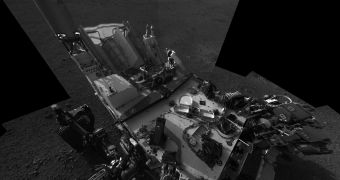Mars Science Laboratory (MSL) mission controllers at the NASA Jet Propulsion Laboratory (JPL), in Pasadena, are currently preparing to take the rover Curiosity out for its first drive. The amazing robot will spin its wheels for the first time tomorrow, or the day after.
Experts want to check the health status of the wheels sometime between August 21-22, officials say. The purpose of the maneuver is not to conduct scientific investigations, but rather to check whether or not the 6 wheels can move freely.
This is very important, since Curiosity's first science target is located around 400 meters (1,310 feet) away of its landing site. Since arriving at Mars, about two weeks ago, the rover only commissioned its cameras and mast-mounted laser, but took no drives.
Getting a robot that weighs nearly 1 ton, and is about the size of a Mini Cooper, inside a crater on another planet is not such an easy task. JPL scientists plan to take things slowly, so that they can avoid a fate similar to what befell the MER rover Spirit back in 2010.
“Basically, we want to drive the wheels more than one rev in both directions. What we've got sketched out right now is about a 4-meter drive forward, and about a 90-degree turn in place, and a couple meters backwards,” Jeff Biesiadecki says.
The JPL expert is one of the 16 drivers responsible for moving Curiosity across the Martian surface. Getting the wheels to move would mean reaching an impressive milestone in commissioning this $2.5 billion mission, whose primary, 2-year objective is to investigate Mount Sharp.
It already began returning scientific results yesterday, August 19, when the mast-mounted laser that is part of the ChemCam instrument was fired at a rock located nearby. Over a period of 10 seconds, 30 million-watt laser pulses – each lasting for only five billionths of a second – were fired at the rock.
“On Sol 15, we're going to check out the steering actuators. We're going to run all the steering actuators one at a time – not through their entire range of motion but through both directions – and end them straight. So we should have all our wheels straight at the end of Sol 15,” the JPL driver says.
“At the end of that maneuver, we'll be taking images of our tracks. We'll see the very beginning of our tracks, which I think is going to be kind of a cool picture,” he concludes, quoted by Space.

 14 DAY TRIAL //
14 DAY TRIAL //